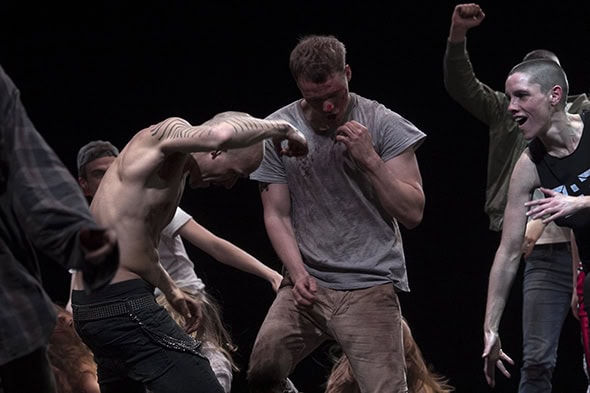Dance Umbrella 2019: Gisèle Vienne’s CROWD at Sadler’s Wells
Posted: October 12th, 2019 | Author: Nicholas Minns | Filed under: Festival, Performance | Tags: CROWD, Dance Umbrella 2019, Extinction Rebellion, Gérard Manset, Gisèle Vienne, Patrick Riou, Peter Rehberg | Comments Off on Dance Umbrella 2019: Gisèle Vienne’s CROWD at Sadler’s WellsGisèle Vienne, CROWD, Dance Umbrella at Sadler’s Wells, October 8

Gisèle Vienne’s CROWD, presented at Sadler’s Wells as the opening event of this year’s Dance Umbrella season, sets not so much a tone for the festival as a standard of engagement. Requiring full attention to its myriad details, it in turn rewards with an afterimage that lasts well beyond the performance.
The setting, like a visual counterpart of Gérard Manset’s ‘un grand terrain de nulle part’, is an earth-strewn stage that suggests an exterior space on which the evidence of messy human occupation ranges from plastic bottles to abandoned clothing; whatever has happened has already finished — or has it? Approaching this ambiguous scene through the high decibel beat of Peter Rehberg playlist of 90’s club music, there is an evident disconnect between the deafening heat of a dance floor and the detritus from the aftermath of an outdoor rock concert, a demonstration or a climactic disaster, while Patrick Riou’s lighting picks out details like a torch searching through the debris for some lost possession. The sound cuts off any aural distractions, so our eyes focus at first on an empty space mired in a past event yet charged with the prospect of something about to happen. Vienne seems to be playing with our expectations by setting up anticipation and then gently diffusing it; when the first hooded figure makes her way across the stage, she is moving so slowly it takes a while to recognize her human agency before our eyes start to make out the details of colour, shape and topography. A second figure enters the stage with the same mystery, ending in a familiar gesture of lighting a cigarette; the smoke becomes not just a recognizable effect but part of CROWD’s visual dialogue. Riou’s lighting adds to the quality of the dialogue by enhancing the depth and volume of the stage and generating through the arrival of the crowd living tableaux that veer from the pictorial to the virtual. Vienne builds up layers of action, behaviour and narrative through a judicious mix of choreography, dramaturgy, colour and light so that the images breathe with the varied dynamics of individual and group behaviour.
There are 15 narratives woven into CROWD that might each take up to 5 minutes to enact in real time, but Vienne calibrates the actions and interactions of each performer using the cinematic devices of slow motion, splicing and freeze frame to expand each 5-minute narrative into a collective performance that lasts 90 minutes. It is as if she focuses an aleatory light on what makes each person move rather than on the movements they make and in doing so builds up a finely detailed composite image of a crowd. The gathering of young people like displaced survivors in what could be construed as a post-industrial environment inevitably lends itself to a poetic comparison with the uncanny proximity and overlap of Extinction Rebellion protests in London. CROWD sees a very human drama unfolding between the individual and the group, and we are caught in the micronarrative of each performer’s struggle for recognition, comfort and intimacy.
Vienne’s manipulation of time also makes CROWD a work about choreographic seeing. How much time do we spend looking at a painting or a photograph in a gallery? Do we not tend to rush past images, searching for immediate gratification? Choreographic narrative and imagery can rush forward like a conveyor belt of emotional returns — sometimes very successfully — but here Vienne draws us into her frame and makes us linger to savour the image she puts before us. In deconstructing the choreographic image, she thus gears what we see to the way we see it.
The time it takes Vienne and her team — writer Dennis Cooper and assistants Anja Röttgerkamp and Nuria Guiu Sagarra — to achieve this experiment in duration is pure theatrical time. The only elements that happen in real time are the mimed conversations between performers — in contradistinction to their slow-motion gestures — and the trajectory of water spilled or ejected from plastic bottles that are evidence of the inevitable pull of gravity. We are reminded of time’s cyclical nature at the end as the performers chart their individual paths away from the gathering into the darkness; against the flow, almost imperceptibly, the first figure can be seen re-entering the stage before the lights dim. As we reach for our scarves we find ourselves back at the beginning; having witnessed this microcosmic crowd of preoccupations on the stage, we prepare to go out into the city night with our own.
Presented by Dance Umbrella in partnership with Sadler’s Wells
Gisèle Vienne is supported by the Institut français as part of FranceDance UK